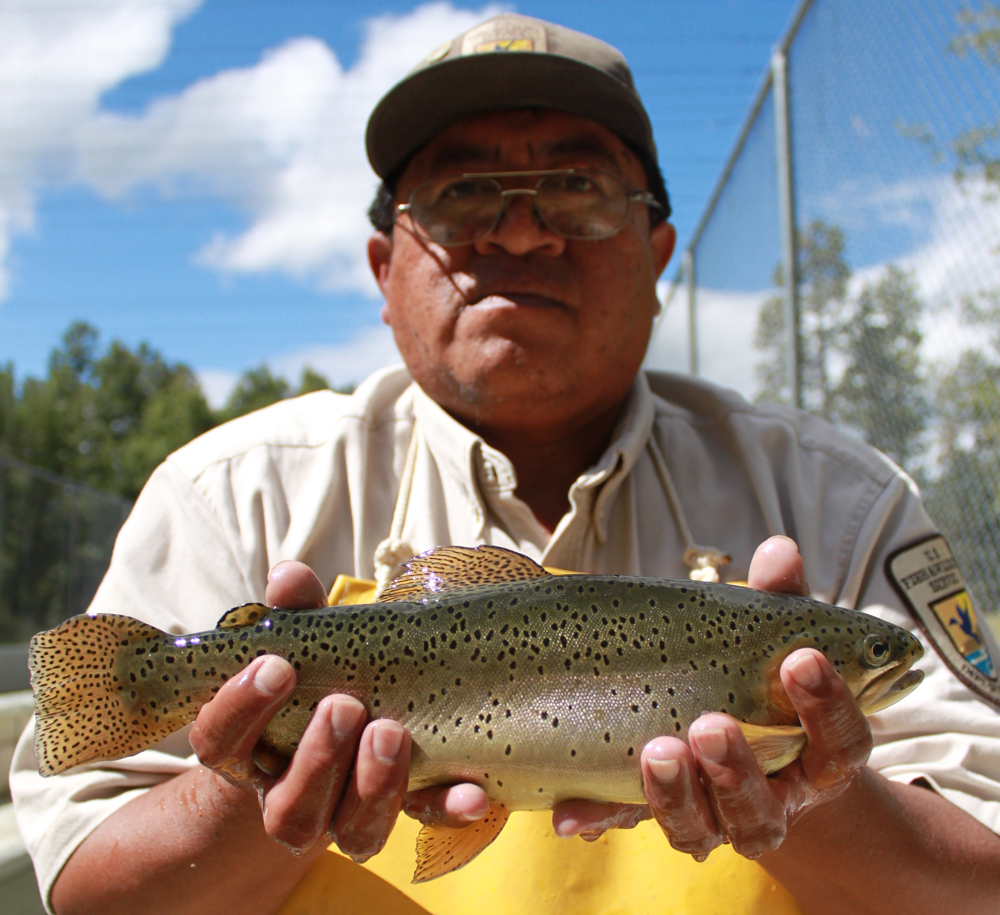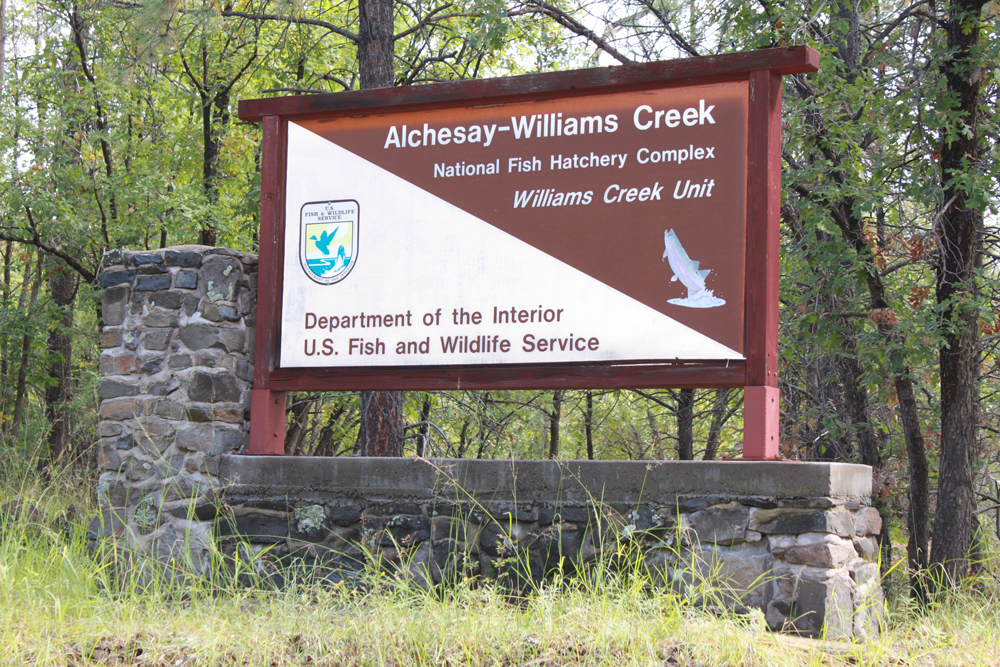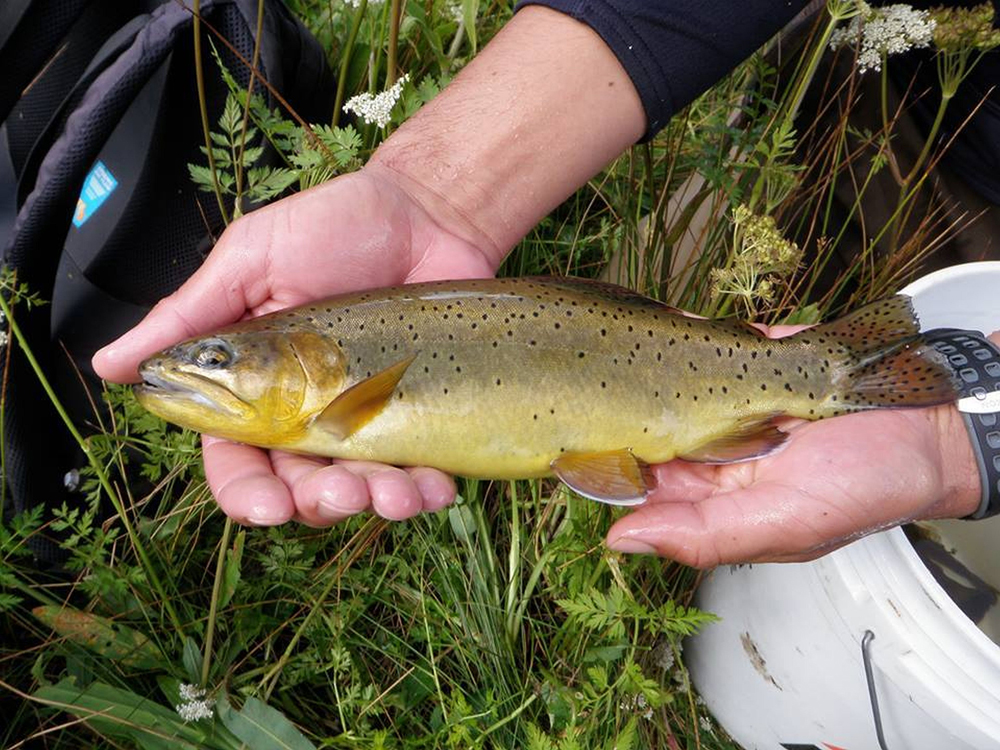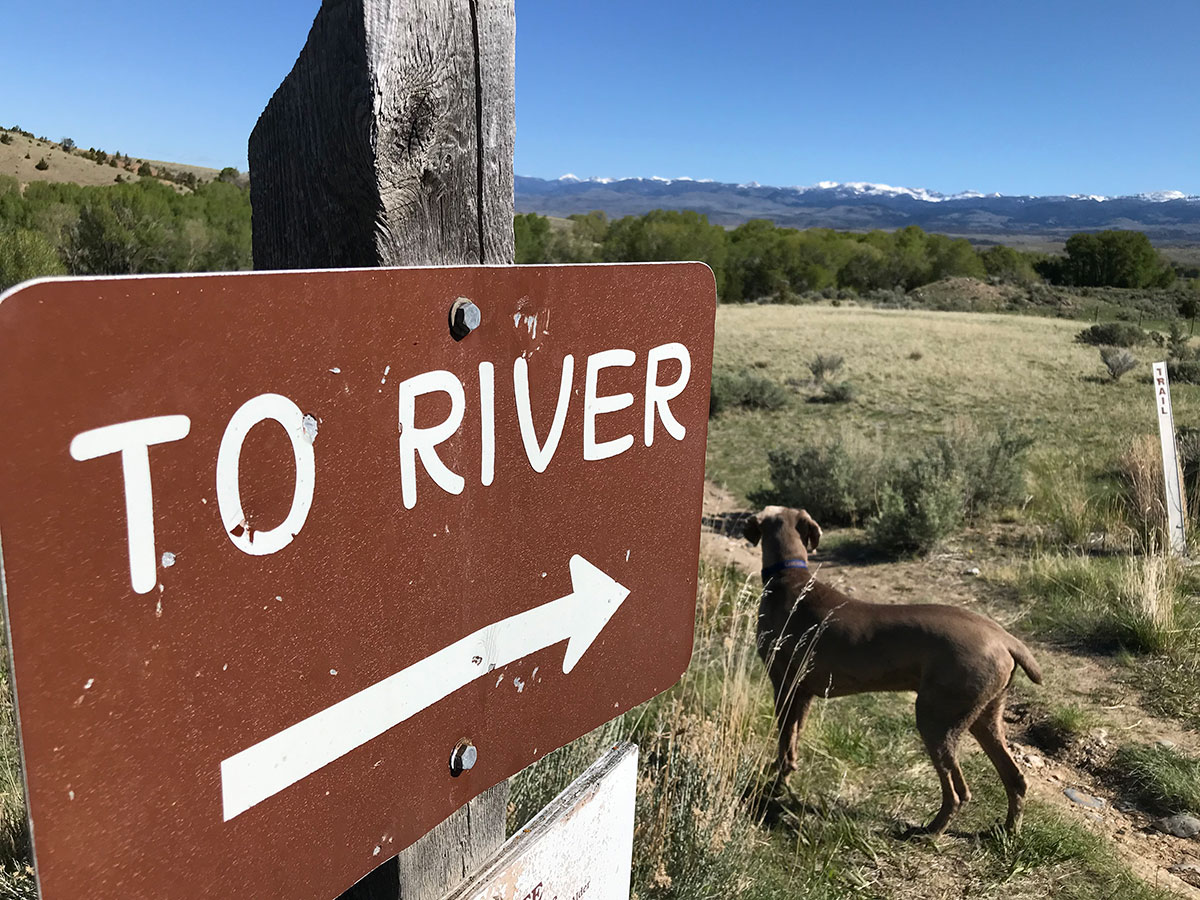The blue lines meandering across maps of eastern Arizona tell a story about the shape of the land and the interactions people have with it. They symbolize the streams that vein off the White Mountains and pour downhill to their inevitable juncture with something larger that may sport another colorful name.
The streams form patterns on the maps that please the eye. Their names enliven the imagination. There’s no poverty of spirit in some of the labels: Hurricane, Moon, Sun, Stinky, Firebox, Paradise, Soldier, Crooked, Peasoup. Two silver rills that spill into Little Bonito Creek remain unnamed by map makers. And that has perhaps the greatest charm of all; it could be that the artifices of mankind have yet to reach this remote place on the Fort Apache Indian Reservation where threatened Apache trout persist. All of these waters harbor some of the last remaining populations of a pretty trout found nowhere else but in streams that rim the White Mountains of Arizona.
The Apache trout is named for the people and the place that are intertwined with one another. The yellow trout, ornamented with black spots, white-tipped fins, and a raccoon-like eye mask, lives naturally only in the headwaters of the White, Black, and Little Colorado rivers near the New Mexico border.

Bradley Clarkson, White Mountain Apache Tribe member and USFWS Apache trout biologist, holds a handsome brood fish at the Alchesay-Williams Creek National Fish Hatchery.
The fish has been familiar to anglers for some time. Local farmers and ranchers made forays into the high country in summer to catch them. One correspondent, simply “J.H.” from Show Low, Arizona, wrote in a July 1886 issue of the St. John’s Herald: “I speak truly when I say it was the most enjoyable period of my life.” He recounted how he and his pals caught scads of Apache trout from the White River during a prolonged summer outing. The sport fishery was renowned.
The Apache trout had become known to science a few years earlier in 1873, when it was collected by members of the U.S. Geographical Survey, though it was wrongly identified as a Colorado River cutthroat trout. Other scientists collected the yellow trout from the White Mountains from time to time, but it wasn’t until a century later in 1972 that the fish was properly recognized as a unique species and assigned its current scientific and common name. A year later it was placed on the Endangered Species List.
That recent scientific description doesn’t mean others had not already known that the trout was something significant. The White Mountain Apache Tribe was prescient, the first to conserve the fish, closing Apache trout streams to angling in the 1940s. By that time the trout had been reduced to a mere 30 miles of streams all within the confines of the Fort Apache Indian Reservation.

Alchesay-Williams Creek National Fishery Hatchery continues to raise Apache trout for sport fishing.
Places everywhere have their scars, and the White Mountains were no exception. The loss of habitat from excessive timbering and grazing and the introduction of non-native trout species were detrimental to the native Apache trout. Over-stocked cattle trampled stream banks and reduced shrubs that would cool trout waters in their shade. Abusive land uses accelerated topsoil erosion into Apache trout streams. High sedimentation during the spring run-off affected trout reproduction; fine sediments clogged porous gravel beds where oxygen-rich water should percolate over incubating Apache trout eggs. To make matters worse, non-native brown trout, brook trout, and rainbow trout were planted in Apache trout streams. All three species out-compete the native fish for food and spaces to live, and rainbow trout hybridize with Apache trout.
Over the last 75 years, through the actions of the White Mountain Apache Tribe, followed by work with the U.S. Fish and Wildlife Service, U.S. Forest Service, and Arizona Game and Fish Department, Apache trout populations have rallied. The future looks sunny for the species; it could be the first sport fish to be recovered and removed from federal threatened or endangered species protection.
Conservation work continues. Cattle have been fenced out of select Apache trout streams within the Apache-Sitgreaves National Forest and along streams within the Fort Apache Indian Reservation. Non-native sport fishes are no longer stocked near Apache trout waters. Alchesay-Williams Creek National Fish Hatchery, located on the reservation, continues to raise Apache trout for sport fishing. Apache trout from the federal fisheries facility are stocked on the reservation, and they are shared with the Arizona Game and Fish Department to be stocked in neighboring national forest waters. Many streams are open to anglers.
Apache trout spawning:
The USFWS’s Arizona Fish and Wildlife Conservation Office (FWCO) biologists remain shin-deep in Apache trout work, striving toward that goal of recovering the threatened species. They expend a great deal of energy removing non-native brown trout and brook trout from Apache trout waters. They accomplish this with backpack-mounted electrofishing gear, where the unwanted fish are stunned and netted from high mountain streams.
A new technology known as environmental DNA guides their work. Fish shed skin cells and, of course, eliminate bodily waste in the water which contains the animal’s DNA. That DNA can be detected in the water.
Biologists from the FWCO and tribe collect stream water from several sites over long reaches. Water passes through a filter, and the filter is analyzed by U.S. Forest Service’s Rocky Mountain Research Station. The lab results then specify which stream sections contain the unwanted non-native trout.

Jake Washburn, USFWS, and Inez Clawson, White Mountain Apache Game and Fish, collect eDNA.
Periodic population monitoring continues, as does barrier monitoring. Where unwanted non-native fishes occur downstream, constructed barriers keep them at bay below and the pure Apache trout populations protected above. Constructed barriers exist on 23 creeks.
Conservation is a laborious affair, but nothing worthwhile ever comes easy. “Make haste slowly,” the adage goes; being deliberate delivers success. Toward that end, the Apache trout lies within the USFWS’s Mogollon Emphasis Area, where it focuses conservation work.
At present, Apache trout exist in 28 populations and swim in 170 miles of stream. The lot of Apache trout has changed significantly over time. In what is really only a brief period, the species has transcended from anonymity and mistaken identity to the point where the White Mountain Apache Tribe stepped up to protect their trout. It’s now the official state fish of Arizona and a favorite for anglers.
Craig Springer, U.S. Fish and Wildlife Service – Southwest Region, External Affairs, Albuquerque, New Mexico. fws.gov/southwest

Distance, Accuracy, Roll Casts, Hauling, Sinking Lines and More
By Lefty Kreh
316 color photos, 6 B&W illus; 8.5×11 inches, 144 pgs.
The legendary Lefty Kreh gives you the building blocks you need for learning to cast. Tips for basic overhead and sidearm cast, roll cast, reach cast, stack cast, tuck cast, curve cast, snap T, change of direction cast, low-side-up cast, speed cast. Tips for keeping your casts under control, casting an extra 20 or 30 feet and much more! Buy Now




